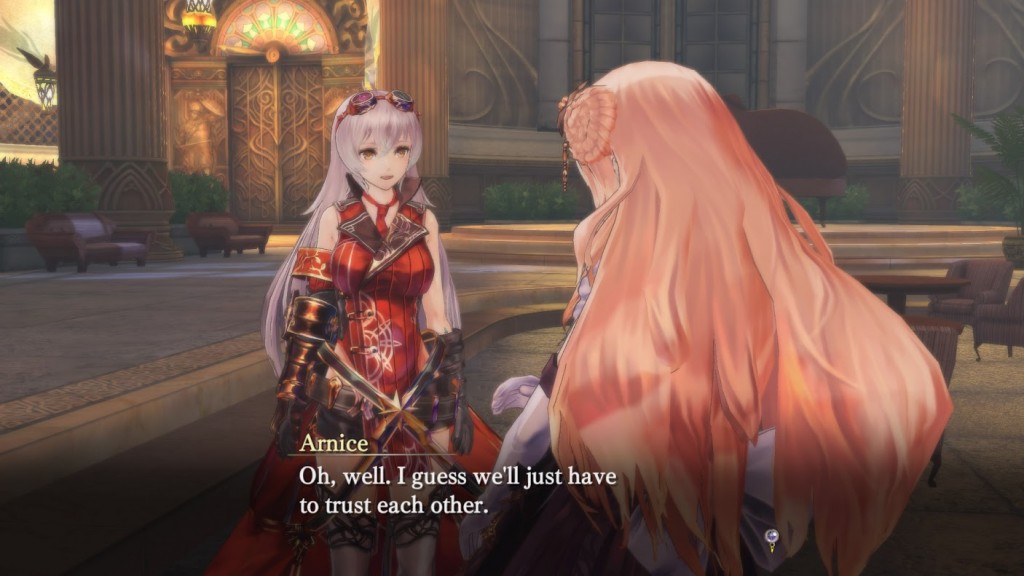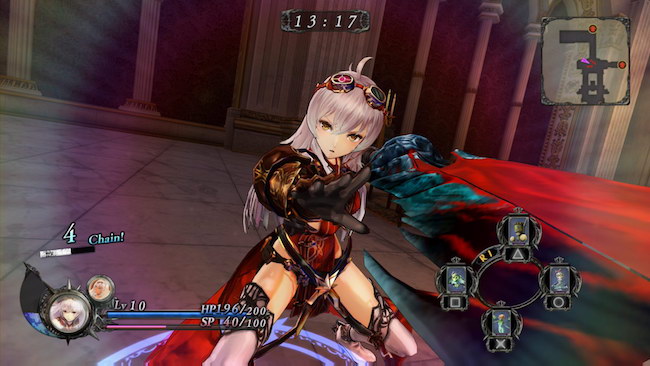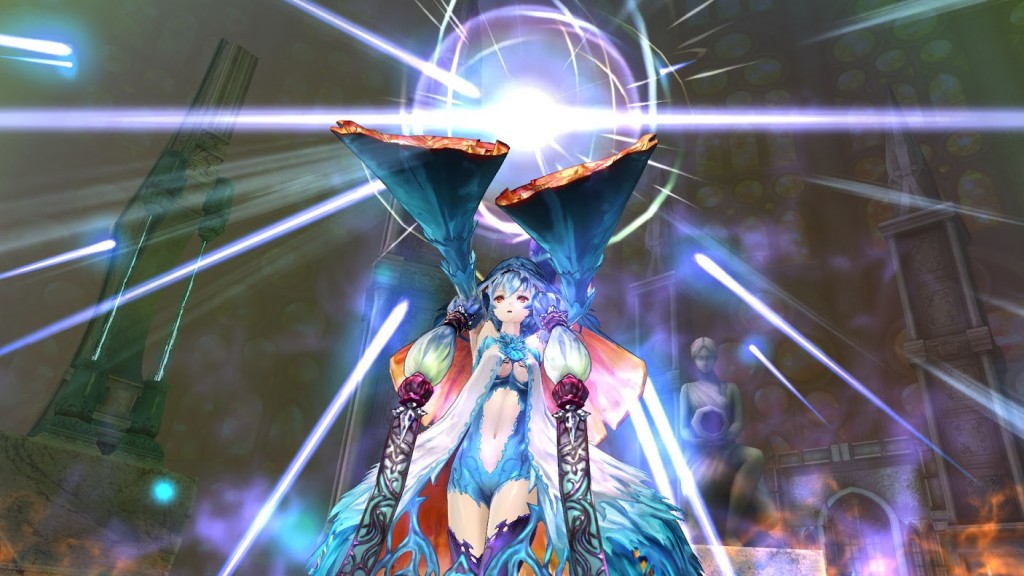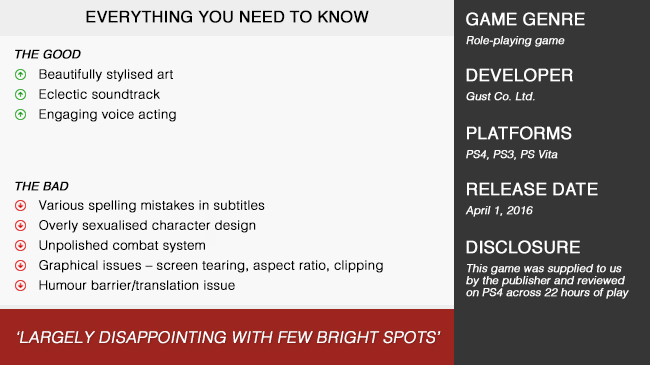
Freshly hitting the physical and digital shelves, Nights of Azure (known by Yoru no Nai Kuni in Japan) is the latest offering from developer Gust. As a bit of background to Gust, they’re a subsidiary arm of Koei Tecmo – but have gained traction on their own accord in the West for the Atelier and Ar Tonelico series. The story of Nights of Azure centers around holy knight Arnice and the priestess Lilysse whom she is sworn to protect. As you quickly come to find out, our two protagonists are pitted against the ominous “Nightlord,” who is slowly but surely about to break the seal that ensnares him and once again attempt to destroy the entire world. I consider myself to be a reasonably seasoned anime fan at this point in my life, so immediately I balked at the synopsis I was given for this game. Regarding originality, I could easily name a handful of anime and game titles which share similar narratives – and in 2016, I’m starting to expect fresher and more unique story ideas than something like this.

Unfortunately, the faults with the narrative don’t stop there. Japanese media can often be pretty overladen with its tropes (as is our own) – for example, the two leads are clearly the “tsundere” (Arnice) and “moe” (Lilyesse) stereotypes which are incredibly prevalent in current day anime and video games. To provide a little explanation for those who aren’t familiar, tsundere characters are often tomboyish in nature – with feelings covered by bluster and frustration in order to distract from their sensitive core, while moe characters are cute, shy and/or clumsy people who need taking care of or protecting due to their ineptitude, giving the character room to grow throughout the story.
While this doesn’t necessarily make the story terrible in itself, the fault then falls to the narrative tone of the story in trying to accommodate these sorts of character archetypes. With a story which presents such a serious synopsis, you would expect probably a relatively heavy/grim atmosphere and delivery – but of course in the traditional Japanese style, they’ve tried to infuse both humour and sincerity into a setting which feels like it doesn’t have room for both. So many animes and games I’ve played have also been structured this way, and while I understand the narrative purpose of it, I feel that the comedy is mostly lost in translation and comes off as being juvenile and crass. Also, while I’d love to be able to congratulate Nights of Azure for being one of the few games I’ve played with dual female main characters, and also for depicting a same-sex relationship in a high budget title – I honestly can’t. Sure, there are certainly moments of genuine tenderness and emotion between Arnice and Lilyesse, but it’s ruined by a list of things – both those above and points still come. The supporting cast of characters also don’t do a whole lot to improve the situation, with 2 of the 3 being the comedic relief to compound the entire issue.

One of the major sticking points in the design was the dialogue, which needs some serious work. If you’re going to release a game which ONLY has Japanese audio with English subtitles, you should probably also make sure to hire someone to proofread the script. Far too many times during cut scenes were there spelling and grammatical errors, which I can forgive from a fansub offering – but not from a title which is commanding $60-70 on release. Personally, it always ruins the immersion for me – the split second I have to reformulate the sentence to make sense brings me out of the experience which is jarring. It was also especially frustrating when it appeared that subtitles had been left out of small cut scenes at the end of the game when there was clearly dialogue being spoken – which also took away a fair bit of my investment towards the ending. Another small point which I found to be a little odd in the design was the way in which you’re directed towards cut scenes. In the current age of game design, there are a lot of devices which allow developers to subtly and overtly guide players to where they would like them to go – whereas Nights of Azure decides to bury the lead completely. As aesthetically awkward as it could be, when you’re moving around, and a character wants to interact with you a huge dialogue box with the word EVENT is emblazoned above their heads. Subtle?
When playing through Nights of Azure, I often found myself thinking of how similar it was to a combination of Tales of Zestiria (which I reviewed late last year) and Final Fantasy regarding combat functionality – except less polished. Engaging in real-time combat, Arnice has an armoury of 4 weapons to scroll through, but most of the combat is reliant on your party of Servans (why didn’t they just add the t?). The Servans are all unique creatures which can be magic users, melee fighters, tanks or support – essentially allowing you to customise how you approach fights based on your style of play. While a great idea, I found that although I had four groups of Servans, I would always just use my main one and rarely ever touched any of the other three. There was certainly potential in what they were trying to develop, but the game needed to be balanced far more in order to allow for a more natural flow of play.

This fact was most notably prominent in the final boss fight – in which the difficulty spike was an incredible leap from the rest of the game. Where I had beaten every boss on my first attempt until then, it took me in the neighbourhood of 15-20 attempts at the final one. Without trying to give away too much, at one point your Servans are temporarily disabled – leaving you to face the boss alone. Despite the fact I was two levels away from the maximum, my Arnice felt so weak and ineffectual that I spent a lot of time ducking and weaving until my Servans were available for re-summoning.
Where I thought Nights of Azure succeeded the most was in how it was presented. Although the actual design was not amazing, with clipping and rare frame-rate drops, as well as some aspect ratio issues in the menu screen, the art style was depicted in true JRPG/anime style which I’m a huge sucker for. The soundtrack was also an added boon, with a combination of J-Pop, soft jazz and orchestral arrangements which helped set the mood depending on what was happening on-screen at the time, and the Japanese voice actors brought on board by Gust gave a natural life to the characters despite my qualms. The only part I was disappointed by was the focus of the graphic design team on “jiggle physics,” which is a real focus issue with high budget studios in Japan (seriously, look it up), and also the character costume design. For example, at one point our holy knight Arnice is wearing nothing but a cape, a piece of cloth barely covering her chest and underwear. WHY?!

As someone who consumes a lot of anime and JRPGs, I was fairly disappointed with what Gust delivered with Nights of Azure. The game is mostly bogged down with stylistic, design and gameplay issues, which left very few elements of the title actually to be duly praised – as even with the things I enjoyed, I still found a particular facet to be either annoying, inappropriate or awful. This sort of thing would be understandable from a smaller studio perhaps – say if it were a launch title, for example. However, with an established company such as Gust (who have several well-received franchises), they should be offering us more for the money they’re asking. But then again, I could be wrong – It reviewed well in Japan, and went on to sell nearly 80,000 physical copies in the first week of release. What do I know?











